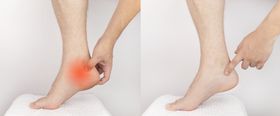Bunions vs. Bone Spurs: Similarities and Differences
Many foot conditions present with similar symptoms including bunions and bone spurs. Here's how their presentation compares and differs from one another.
Published February 28, 2022
Pain is a symptom of many foot conditions, some having similar presentations. Yet a proper diagnosis is necessary for the correct treatment to take place. Two such similar conditions are bunions and bone spurs.
Continue reading to learn about each one and their key differences.
What Is a Bunion?
A bunion is a bony bump on the outside of the big toe. It is caused by continuous pressure on the metatarsophalangeal joint (MTP), caused by conditions like foot injury, inflammatory arthritis, and more.
Symptoms include pain, redness, and soreness. The pain is generally described as aching in nature, worse after activity, and can progress if not treated.
Complications include worsening pain (burning sensation), stiffness, hammertoe deformity, and corns or calluses.
What Is a Bone Spur?
A bone spur is a bony outgrowth caused by calcium deposition in joints. They can occur on any part of the body—the foot, knee, hip, spine, neck, etc. Generally, bone spurs are asymptomatic until they press on nerves and cause radiating pain.
Bone spurs are caused by osteoarthritis, foot injury, obesity, tight-fitting shoes, and genetics, among others.
How to Diagnose Bunions and Bone Spurs
When bone spurs occur on the big toe, it can be difficult (but not impossible) to differentiate them from one another. To arrive at an accurate diagnosis, you must critically examine the symptoms and presentation.
The most distinct difference is that while bone spurs are bony outgrowths, bunions are bony deformities. Again, while bone spurs occur on top of the big toe and in many other places, bunions occur only on the outside of the big toe.
Also, pain due to bunions is aching and worse after activity, while pain due to bone spurs is radiating in nature and limits activity in the first place.
An X-ray may be a useful way to differentiate between them.
Related Articles

Do High-Top Basketball Shoes Help Reduce the Risk of Injury?
Upstep Staff
October 15, 2024

How to Reduce Pain from Past Injuries to Improve Quality of Life
Upstep Staff
December 20, 2024

Heel Spurs: An Overview of Symptoms, Causes, and Treatments
Janik Sundstrom
December 7, 2022

Prevent Shin Splints with Compression Socks: Tips and Tricks
Janik Sundstrom
October 15, 2024

Metatarsal Pad Insoles: Can They Cure Your Foot Pain?
Janik Sundstrom
December 12, 2024
Related Posts
Babafemi Adebajo
Orthotics for Bunions: How Insoles Can Relieve Bunion Pain
Janik Sundstrom
Bunions vs. Bone Spurs: Differences & Similarities
Babafemi Adebajo
Best Tennis Ball Exercises for Plantar Fasciitis
Dr. Pooja Gajare
Tailor’s Bunion: Causes, Symptoms, and Treatment
Babafemi Adebajo
7 Best Insoles for Bunions: Aid Toe Alignment
Janik Sundstrom
Ankle Pain Symptom Checker: Why Your Ankle Hurts
Janik Sundstrom



